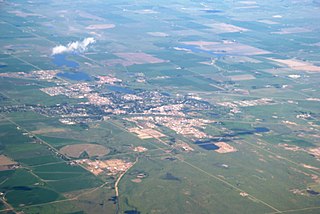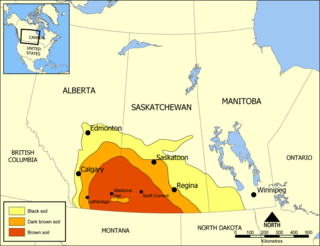
Palliser's Triangle, or the Palliser Triangle, is a semi-arid steppe occupying a substantial portion of the Western Canadian Prairie Provinces, Saskatchewan, Alberta and Manitoba, within the Great Plains region. While initially determined to be unsuitable for crops outside of the fertile belt due to arid conditions and dry climate, expansionists questioned this assessment, leading to homesteading in the Triangle. Agriculture in the region has since suffered from frequent droughts and other such hindrances.

The City of Armstrong is located in the North Okanagan of the Canadian province of British Columbia, between Vernon and Enderby. It overlooks the Spallumcheen Valley, which forms a broad pass between the Okanagan Valley to the south and the Shuswap Country to the north, and is about 480 km (300 mi) from each of Vancouver, B.C., Calgary, Alberta, Spokane and Seattle, Washington. The town of Armstrong celebrated its centennial in 2013.

David Richard Swann, is a medical doctor and Canadian politician. He currently serves as the Member of the Legislative Assembly of Alberta for Calgary-Mountain View, and is a member of the Liberal Party. He was the leader of the Alberta Liberal Party and Leader of the Opposition in the Alberta Legislature from December 2008 until resigning as party leader in September 2011. He returned as interim leader of the Alberta Liberal Party on February 1, 2015, following the resignation of Raj Sherman and led the party through the 2015 provincial election.

Irvine is a hamlet in Alberta, Canada within Cypress County. It is located approximately 35 kilometres (22 mi) east of Medicine Hat on Highway 1 and has an elevation of 763 metres (2,503 ft). The hamlet is located in census division No. 1 and in the federal riding of Medicine Hat.
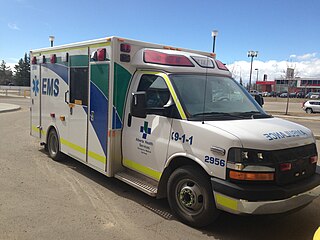
A paramedic is a healthcare professional, providing pre-hospital assessment and medical care to people with acute illnesses or injuries. In Canada, the title paramedic generally refers to those who work on land ambulances or air ambulances providing paramedic services. Paramedics are increasingly being utilized in emergency rooms by providing patient care in collaboration with physicians, physician assistants, nurse practitioners, registered nurses, registered practical nurses and registered respiratory therapists. Increasingly in Canada, paramedics are actively pursuing self-regulation.
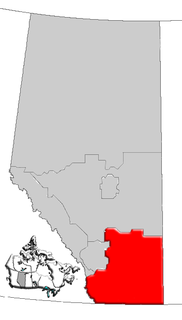
Southern Alberta is a region located in the Canadian province of Alberta. In 2004, the region's population was approximately 272,017. The primary cities are Lethbridge and Medicine Hat. The region is known mostly for agricultural production, but other sectors, such as alternative energy, film production and tourism, are emerging.
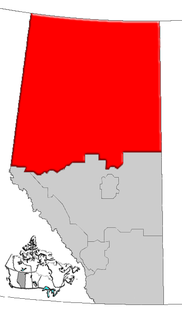
Northern Alberta is a region located in the Canadian province of Alberta.
Human immunodeficiency virus and acquired immune deficiency syndrome in Burma, recognised as a disease of concern by the Ministry of Health and is a major social and health issue in the country. In 2005, the estimated adult HIV prevalence rate in Burma was 1.3%, according to UNAIDS, and early indicators show that the epidemic may be waning in the country, although the epidemic continues to expand in parts of the country. Four different strains of HIV are believed to have originated from Burma, along heroin trafficking routes in northern, eastern and western Burma.
Emergency medical services in Canada are the responsibility of each Canadian province or territory. The services, including both ambulance and paramedic services, may be provided directly by the province, may be contracted to a private provider, or may be delegated to local governments, which may in turn create service delivery arrangements with municipal departments, hospitals or private providers. The approach, and the standards, vary considerably between provinces and territories.

Peter Lougheed Centre (PLC) is a 506,000 square foot hospital in Calgary, Alberta, Canada. It is under the auspices of Alberta Health Services, formerly the Calgary Health Region, providing medical and surgical services to Calgary but also Southern Alberta. The PLC has a 24 hours emergency department, an intensive care unit (ICU), Level IV trauma centre and offers ambulatory care. It was named after Peter Lougheed, who served as premier of Alberta from 1971 to 1985. The hospital opened in 1988 with 500 beds, and today contains over 600 beds. The new East Wing was completed in 2008 and includes 140 inpatient beds, as well as a new intensive care and coronary care unit. It was also designed with a new roof-top helipad for emergency services.
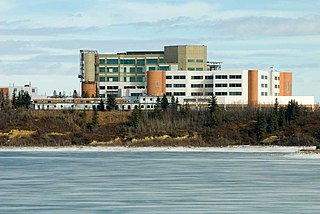
Rockyview General Hospital (RGH) is a large hospital. It is located in the city of Calgary, Alberta, Canada, on the shores of the Glenmore Reservoir and is administered by Alberta Health Services and formerly by the Calgary Health Region.

The Royal Alexandra Hospital (RAH) is a large and long serving hospital in the Canadian province of Alberta. Operated by Alberta Health Services and located north of Edmonton's downtown core, the Royal Alexandra serves a diverse community stretching from Downtown Edmonton to western and northern Canada. The total catchment area for the RAH is equivalent to 1/3 of Canada’s land mass; stretching north from Downtown Edmonton to enpass both the Northwest Territories & Yukon territory, and stretching as far west as British Columbia's pacific coast.

The Libin Cardiovascular Institute of Alberta is a partnership between Alberta Health Services and the University of Calgary. Its mandate comprises all cardiovascular research, education and service delivery, with a service area extending from Saskatchewan, Southern Alberta and Eastern British Columbia. The Institute coordinates the activities of 1,500 individuals in Southern Alberta. Of its more than 175 research and clinician members, over 65 are cardiologists, making it the largest heart or cardiovascular institute in Western Canada by that measure.

Manmeet Singh Bhullar was a Canadian politician and Member of the Legislative Assembly of Alberta who represented the constituency of Calgary-Greenway as a Progressive Conservative. He served as a cabinet minister from 2011 until the defeat of the Progressive Conservative government in 2015. He was widely seen as a rising star in the Progressive Conservative caucus. Bhullar was killed when he was struck by a tractor trailer on a road when he went to help a stranded motorist on November 23, 2015.
Alberta Health Services (AHS) is the single health authority for the Canadian province of Alberta.
The Canadian Council on Learning was a channel for lifelong learning, encouraging and supporting data-based decisions about learning during all stages of life, from early childhood through to the senior years. The organization received about 85% of its funding from the Government of Canada, which announced in January 2010, that it was not renewing its funding. The organization's website is no longer available.
Arya Mitra Sharma is Professor of Medicine and currently holds the Alberta Health Services Chair in Obesity Research and Management at the University of Alberta and Medical Director of the Alberta Health Services Obesity Program. In 2006 he founded and is currently Scientific Director of the Canadian Obesity Network and Past-President of the Canadian Association of Bariatric Physicians and Surgeons. He also serves on numerous committees of professional organizations including The Obesity Society (TOS) and the International Association for the Study of Obesity (IASO).
The Palliser Region is an area in the southeast corner of the province of Alberta, Canada that has been delineated and is serviced by the Palliser Economic Partnership. It borders the Canadian province of Saskatchewan to the east, and the US state of Montana to the south. It covers an area of 43,504 km2 (16,797 sq mi) The total population of the area stood at 112,314 in 2009. The city of Medicine Hat, with a population of 61,097, is the area’s largest urban centre.
The Alberta College of Social Workers (ASCW) serves as the regulatory body for the profession of social work in the province of Alberta, Canada. It is among one of 30 healthcare professions legislated under the Alberta's Health Profession Act (HPA). The College provides membership activities that promote the engagement of ethical social work practice as well as policies, programs, and services that enhance the public interest.

Research Manitoba is a government-funded organization based in Winnipeg, Canada that promotes, supports and coordinates the funding of research in health, natural and social sciences, engineering and the humanities in the province of Manitoba. It was created in 2014 by the provincial government to advise the then, Minister of Jobs and the Economy on matters related to research, and with funding received from the province, provides funds for research through a number of grants and awards programs.


